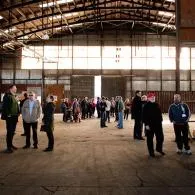Perspective
Written by

It has been six months since everything changed for Christchurch. Jeff Clark looks back, looks around and looks forward to the future for the city, people and arts scene.
"Those first few weeks were probably the hardest any arts groups or artists have faced in New Zealand: where, when and how can the city, let alone the arts it once fostered, recover?
The heart of the city stopped beating, and we were put on emergency bypass."
Looking Back
It’s hard to believe it has been half a year since the February 22 earthquake. At times my reaction is “really? It feels like yesterday” and sometimes it feels like longer. Such is the nature of perception.
I don’t want to downplay the September quake – certainly it started the ball rolling, so to speak – but given there was no loss of life and only some scattered structural damage in the central city, we had been given something of a false sense of security. In September, getting most performing arts groups/venues up and running again was a relatively simple process: engineering assessments, green light and back on we went (or not, if there was damage). There was no major damage. There were no deaths. The city had been shaken, but everything went back to normal (or very close to normal) relatively quickly.
Then came February.
The sheer shock to the city was exponentially larger than September: it happened in broad daylight, numerous lives were lost and buildings – including the Cathedral, a symbol for the city itself - came down in an instant.
For the arts especially it was a severe trauma. Almost every major venue was lost. The Mill Theatre and Repertory Theatre were quickly marked as casualties. The Issac Theatre Royal was diagnosed as critical, with repairs taking until 2013. The James Hay Theatre and Town Hall are having their charts regularly checked but the prognosis looks grimmer day by day. Studios and galleries were cut off, paint or materials trapped behind the fences.
The Arts Centre was swiftly put into an induced coma: tenancies cancelled (and, following June 13’s aftershock) access denied and contents most likely irretrievable. The price tag for repairs is over $100 million; the time frame is years. The question of when it can return to its role as a cultural hub for arts, crafts and entertainment in the city will not be answered for some time.
Those first few weeks were probably the hardest any arts groups or artists have faced in New Zealand: where, when and how can the city, let alone the arts it once fostered, recover?
The heart of the city stopped beating, and we were put on emergency bypass.
Looking Around
So, where are we now?
After six months, the central city is still closed off with demolitions underway. The Mill Theatre will be demolished, the Repertory Theatre already has. The Loons in Lyttelton is damaged, the Ngaio Marsh theatre at the University (and the whole Students’ Association building itself) is out of order for the foreseeable future. The Town Hall and the James Hay theatre are out of action until 2012, the Isaac Theatre Royal will not be operational until 2013, meaning groups like the CSO or Showbiz have lost their primary venue - as has anyone considering staging a large-scale production in Christchurch.
The Court Theatre quickly to set to work to find a place that it could re-establish itself at – ultimately settling on an old storage silo in Addington. Construction has started, fundraising is underway and (if both things go well) the theatre will re-open by the end of the year. Acknowledging that I may not have the best perspective; it seems that The Court has managed an incredible amount in a short space of time – bolstered, of course, by very strong community support.
Christchurch Polytechnic has become a haven for arts organisations whose offices are either in ruins or inside the Red Zone by creating a “Cultural Hub” on the CPIT campus. With a common plight and shared space, many of these organisations have found a renewed sense of cooperation, if not collaboration.
The Christchurch Arts Festival completely changed its programme and planned a festival with no way of knowing what state the city would be in. Given the attendances and reviews thus far, it seems likely the festival will be a resounding success. The festival has also been a boost for many local arts groups including The Loons, who are literally performing amongst the rubble of their home in Lyttelton.
Creative New Zealand has come to the fore with support for the arts in Christchurch. Their subsidy of Arts Festival shows (every show is just $20) means that the people of Christchurch are able (and more willing) to attend. Their emergency grants and funding have meant several organisations that would have otherwise perished can now begin to look towards the future.
Amateur groups have adapted to their circumstances, as they have always done. Elmwood Theatre, once home to the Elmwood Players, now share their venue with Riccarton Players, Repertory and many other groups. For these groups, it is more about the people and the passion than it has been about the money – where no space is available, space is being found (or made).
Similarly, visual artists, comedians, musicians and other solo or small groups of practitioners have quickly taken new opportunities, making their own work (or venues) when none are available. As new bars and business open around the city (or existing businesses find new premises), windows of opportunity are starting to open.
Looking Forward
The demolition of the city is well underway, and hopefully once that is complete there will be swift growth from the rubble as spring arrives.
The draft city plan, released just over a week ago, is an ambitious plan to rebuild the city. This plan embraces the arts as a central part of city life, and embraces the opportunity to incorporate them in the city rebuild. Over the next decade proposals include re-establishing arts and crafts studios in the central city, a public art network running through the heart of the city, re-establishing the performance facilities that can be repaired and constructing new facilities - including a community rehearsal/performance venue (by 2015) as well as a professional theatre facility (to be built by 2019).
The latter two proposals are most exciting to me, as someone who works in theatre. A new professional theatre in the heart of the city has the most obvious benefits to the central city. Personally, I find the community theatre space most exciting - this kind of space is long overdue and would do great things to foster (and retain) the talent within the city, who could then move on to professional productions in Christchurch and throughout the country.
Of course, this vision for the future has already met with some detractors. In fact, one notable politician called it “an expensive wish list”. Of course it is a wish list – Christchurch has faced a harsh reality for half a year; to wish for a city that recreates and enhances those things we loved so much about it is not only justified but should be encouraged. Financial reality will set in soon enough; for now, hope is the one resource that costs nothing to supply.
Self-Examination
Personally, the past six months have been one of the most interesting times of my life (to quote the old Chinese curse).
I’ve lost the Arts Centre, which has been more than a workplace for me – it was the place that introduced me to the theatre and introduced me to improv (which led me to my career), it was the place I had my first play performed and, rather than in a church, my wife and I chose to get married in Court One. I have gone from feeling like an integral part of the complex to an outsider looking in - and I doubt I will get that feeling back. It’s not a nice thing to think about.
I have bounced up and down the country, wife and two kids in tow (my daughter turned one on August 20th, which boggles my mind). I have worked with familiar faces in unfamiliar spaces and unfamiliar faces in unfamiliar places, all the while learning exactly what “getting back to the business of entertaining the people of Christchurch” actually means.
Currently, I am working in a temporary office on the outside of The Shed. In around five weeks the permanent interior offices will arrive and we will take the larger step of moving into the space. We have fundraising activities coming up. A draft season has been put together and these productions (and the new venue) will require a new approach in promotion and publicity.
My focus on the future is, for now, more concerned with the next year and half than the next decade.
I’m looking forward to seeing what’s next.
